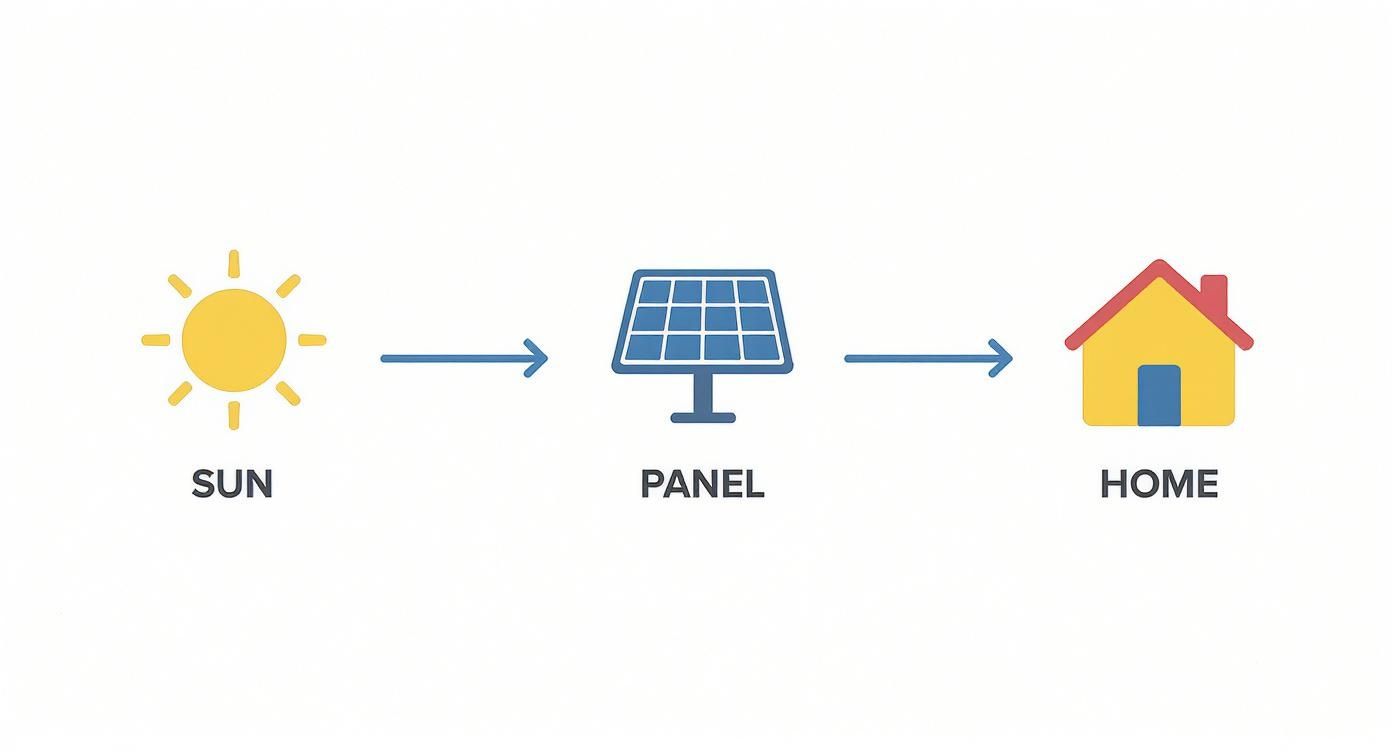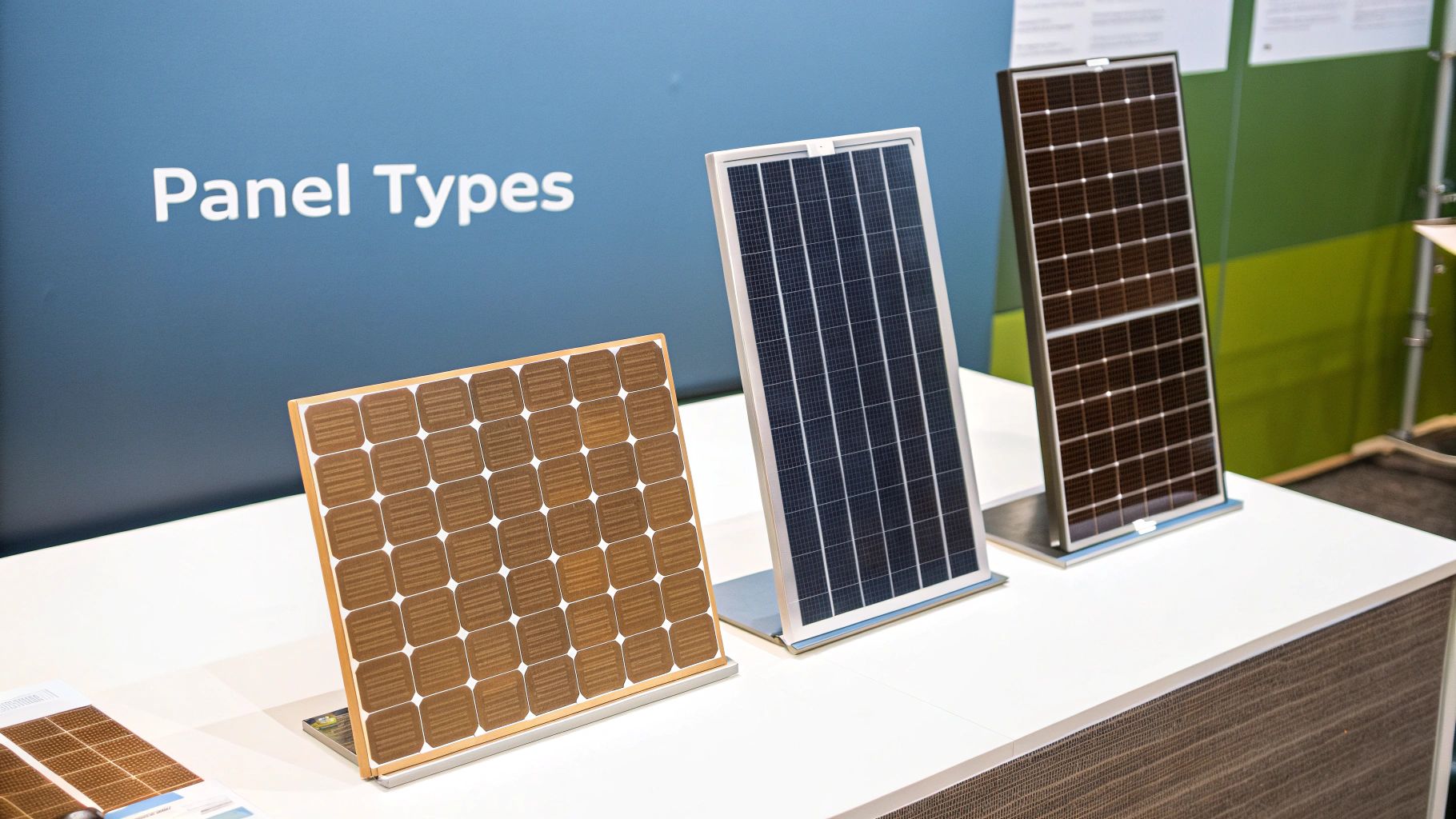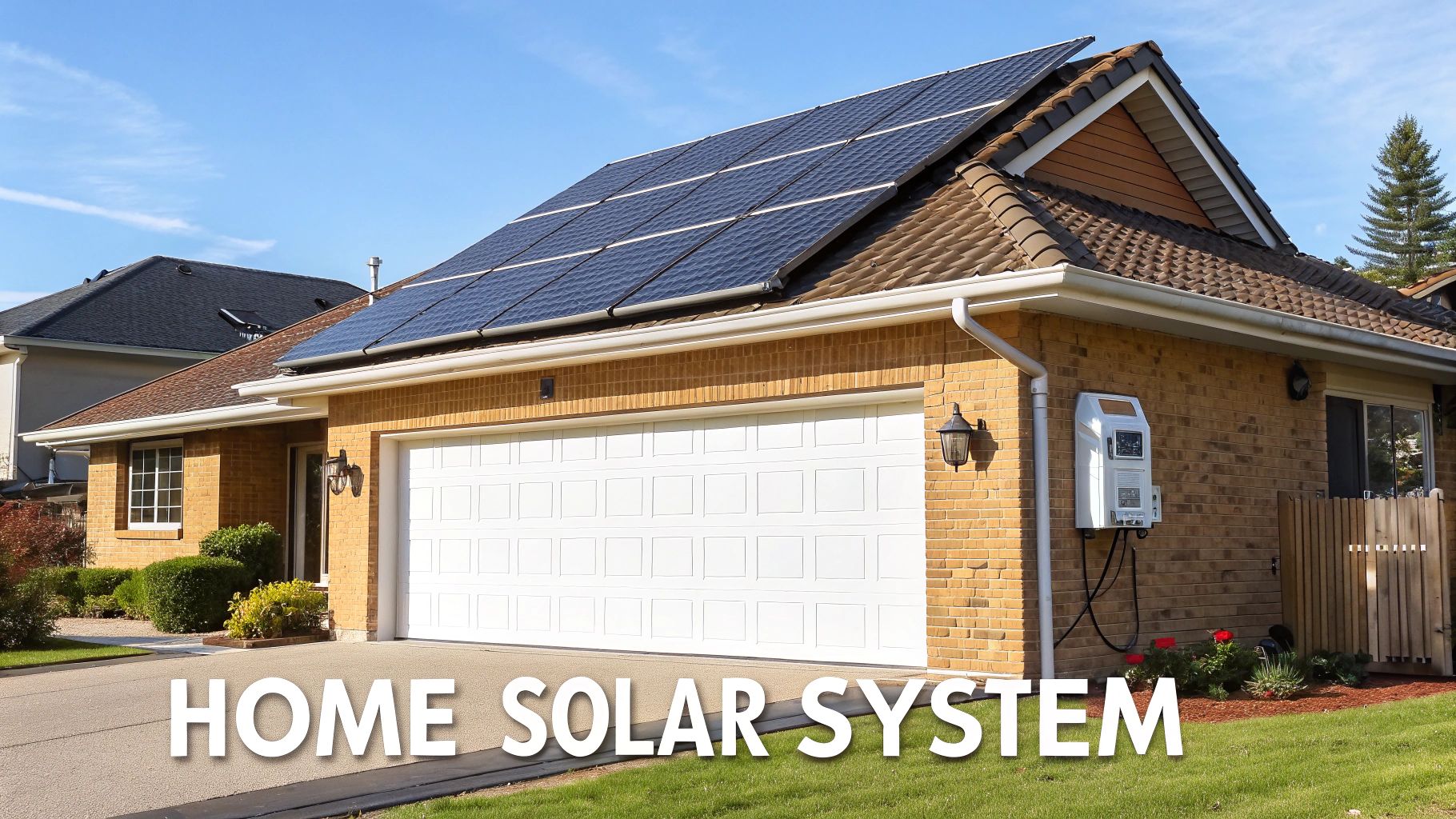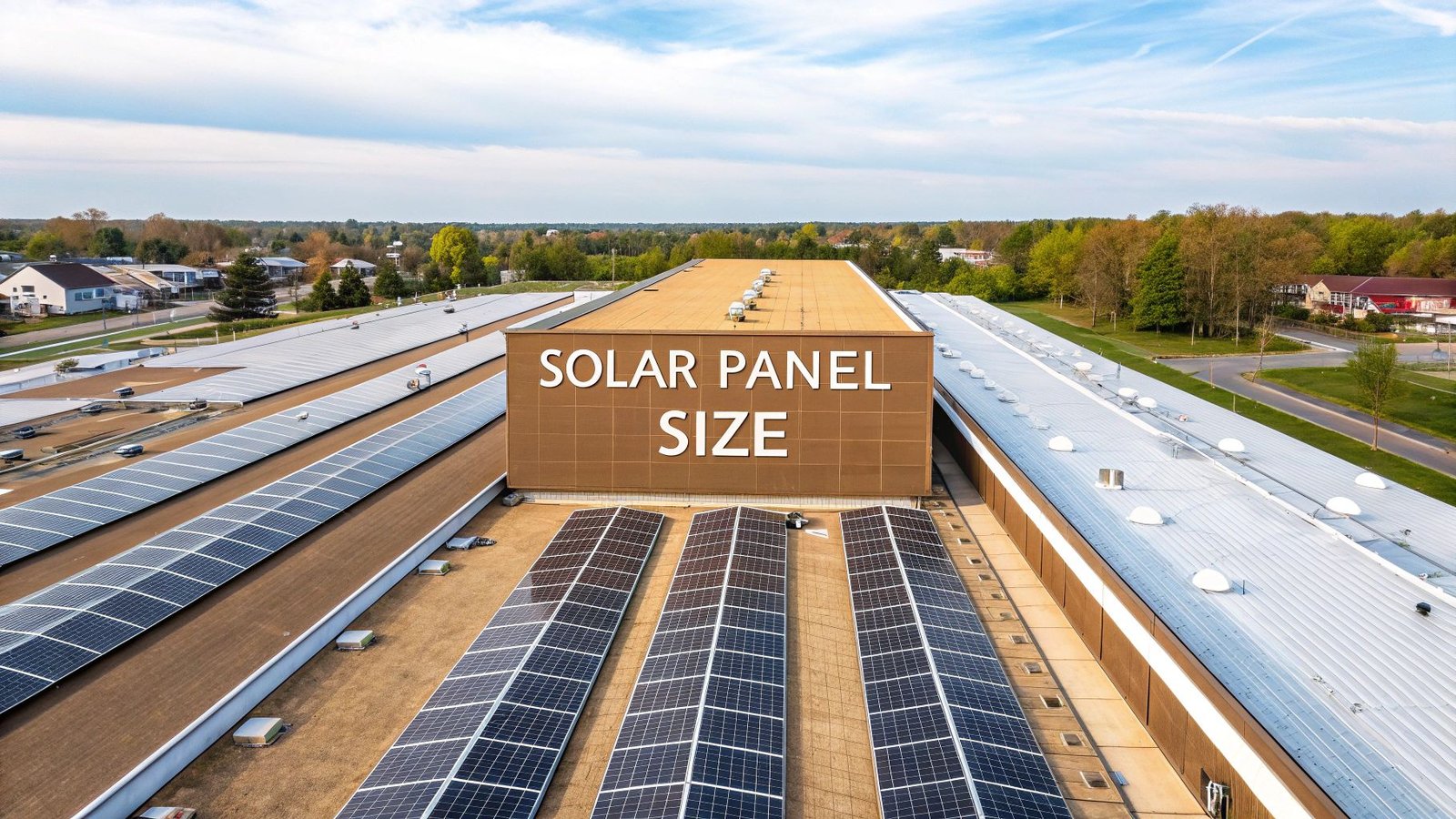At its most basic level, a solar cell takes sunlight and turns it directly into electricity. The magic ingredient is usually a special semiconductor material, most often silicon. When sunlight—which is made of tiny energy packets called photons—hits the cell, these photons knock electrons loose from the silicon atoms.
This is the key. Getting those electrons moving creates an electrical current, a process scientists call the photovoltaic effect. It’s this elegant, silent reaction that transforms your rooftop into a personal power station.
How Sunlight Becomes Your Home's Electricity
Think of each individual solar cell as a tiny engine that only runs on light. While the physics can get complicated, the core idea is beautifully simple. It's a clean, direct conversion of sunlight into usable power, and once you grasp it, the technology powering your home no longer feels like a mystery.
Inside every solar panel, millions of these tiny engines work together in perfect sync to produce a meaningful amount of electricity. This collective effort is what powers your lights, charges your phone, and can even run an electric car. That same solar energy can also be used for specific tasks, like running highly efficient solar roof ventilation fans to keep your attic cool.
The Journey From Discovery to Your Rooftop
This idea isn't brand new—it’s built on more than a century of scientific breakthroughs. The photovoltaic effect was first noticed way back in 1839. But the real starting pistol for modern solar technology was fired in 1954 at Bell Labs, when they created the first practical silicon solar cell.
That first cell was only about 6% efficient, but it was a monumental leap. It set the stage for decades of innovation, pushing efficiency from 10% in 1959 to well over 30% in today's advanced lab settings. This steady progress is what turned solar from a niche science experiment into a powerful global energy solution. You can explore more of these incredible milestones in solar cell development to see just how far we've come.
The process is beautifully efficient: photons from the sun strike solar panels, excite electrons, and produce usable power. It's a technology that was invented right here in America.
Quick Guide How Light Turns Into Power
So, how does a sunbeam actually become the power that flips on your light switch? Let's walk through the journey step-by-step. The whole conversion happens in a fraction of a second, but it involves a few critical actions inside the solar cell.
| Step | What Happens in the Cell | Simple Analogy |
|---|---|---|
| 1. Absorption | Photons (light particles) from the sun strike the silicon solar cell. | A cue ball (photon) hitting a rack of billiard balls (electrons). |
| 2. Excitation | The photon's energy knocks an electron free from its atom. | The impact scatters the billiard balls, setting one in motion. |
| 3. Collection | An internal electric field directs the freed electrons to one side of the cell. | A sloped table guiding the moving ball toward a specific pocket. |
| 4. Flow | The collected electrons flow through an external circuit, creating a direct current (DC). | The ball rolling down a track, creating a continuous flow of motion. |
This elegant four-step dance happens billions of times a second in every single cell on your roof. It's this constant, silent flow of electrons that adds up to produce all the clean electricity your home needs.
Unlocking the Photovoltaic Effect
At the very core of every solar cell is an amazing natural phenomenon: the photovoltaic effect. It's the science that explains how a solar cell can take pure sunlight and convert it directly into electricity, all without a single moving part. This process is silent, clean, and happens the instant sunlight hits the panels on your roof.
Think of a solar cell as having a built-in, one-way street just for electrons. To create this street, we start with a semiconductor material—almost always silicon—and give it a special two-layer structure.
Creating the Electron Highway
On its own, pure silicon isn't a great conductor of electricity. So, manufacturers intentionally introduce tiny impurities into the silicon crystal, a process known as doping. This step creates two distinct, specialized layers that are key to the whole operation.
- The N-Type Layer: This top layer gets a dose of an element like phosphorus, which has more electrons than silicon does. These extra electrons are free-floating, giving the layer a negative charge (that's the "n" in n-type).
- The P-Type Layer: The bottom layer is treated with something like boron, an element with fewer electrons than silicon. This creates tiny vacancies, or "holes," where electrons should be, giving this layer a positive charge (the "p" in p-type).
When you put these two layers together, something really interesting happens. The free electrons from the n-type side are immediately drawn to the empty holes on the p-type side. They meet right at the boundary, which we call the p-n junction. This migration of charges creates a permanent and powerful electric field right across that junction. Our one-way street is now open for business.
Putting Sunlight to Work
With the structure in place, the real magic begins when a photon—a tiny particle of sunlight—strikes the solar cell. If it hits a silicon atom with enough energy, it knocks an electron loose, leaving a hole in its place. This is what's known as creating an electron-hole pair.
Now, if that electric field wasn't there, the freed electron would just fall back into the nearest hole, and nothing would happen. But the field at the p-n junction acts like a strict traffic cop.
The electric field instantly shoves the negatively charged electron toward the n-type layer while pushing the positively charged hole toward the p-type layer. This forced separation is the absolute key to generating an electrical current.
By preventing the electron and hole from getting back together, the field forces the electron to find another route. It has to travel up through the n-type layer, out of the cell, and through an external circuit—like the wiring connected to your home—to finally make its way back to a hole on the p-type side. This continuous flow of billions of electrons is exactly what we call electricity.
This infographic breaks down that journey from the sun to your home.

The electricity produced this way is Direct Current (DC), meaning the electrons flow in just one direction. Since our homes and appliances run on Alternating Current (AC), this DC power has to be converted by another crucial piece of equipment: the inverter.
Getting a handle on how these layers work together is the first step. To see how these tiny cells are bundled with other components to create the final product on your roof, you can explore the different parts of solar panels in our complete guide.
Comparing Different Types of Solar Cells
Not all solar cells are created equal. Think of it like choosing an engine for a car—different models are built for different jobs. The same is true for solar cells, and the three main types you’ll come across are monocrystalline, polycrystalline, and thin-film.
Understanding what sets them apart is the first step to figuring out which kind of solar panel will work best for your home, your roof, and your budget. Each one strikes a different balance between efficiency, cost, and even how it looks.

Monocrystalline: The High-Efficiency Choice
Monocrystalline cells are the premium pick in the residential solar world. You can spot them easily by their uniform, sleek black color and the signature clipped corners on each cell. They get their name because they're made from a single, ultra-pure silicon crystal, which creates a perfect, unobstructed highway for electrons to travel.
This flawless crystal structure is exactly why they perform so well. With almost no impurities to get in the way, more electrons can move freely and generate more power. This results in the highest efficiency ratings on the market, typically landing somewhere between 15% y 22%. If you want to squeeze every last watt of power out of a small roof, monocrystalline panels are your best bet.
Polycrystalline: The Practical Performer
Next up, we have polycrystalline cells, which you'll recognize from their distinctive blue, marbled look. Instead of being grown from one perfect crystal, these are made by melting down multiple silicon fragments together. This manufacturing process is simpler and less wasteful, which makes them a more budget-friendly option.
The trade-off is that this process creates "grain boundaries" inside the cell where all those different crystals meet. These boundaries act like tiny speed bumps for electrons, slowing them down just enough to lower the overall efficiency. You'll typically see these panels rated between 15% and 20%. For homeowners with plenty of roof space, polycrystalline panels offer a fantastic blend of reliable performance and a lower upfront cost.
Thin-Film: The Flexible Innovator
Thin-film solar takes a completely different route. Instead of slicing up rigid silicon wafers, this technology involves spraying or depositing ultra-thin layers of photovoltaic material onto a flexible backing like glass, plastic, or metal. This makes the final product incredibly lightweight and bendable.
While thin-film is still playing catch-up on the efficiency front—usually hovering between 10% and 20%—its unique design opens up a world of new uses. It can be integrated directly into roofing materials or installed on curved surfaces where traditional panels just wouldn't work.
To make things a little clearer, here’s a quick rundown of how these three technologies stack up for a typical residential project.
Feature Comparison of Common Solar Cell Technologies
| Cell Type | Key Material | Typical Efficiency | Apariencia | Lo mejor para |
|---|---|---|---|---|
| Monocristalino | Single-crystal silicon | 15% – 22% | Uniform black, clipped corners | Homes with limited roof space needing maximum power output. |
| Policristalino | Multi-crystal silicon | 15% – 20% | Blue, marbled pattern | Budget-conscious homeowners with ample, unobstructed roof space. |
| Capa fina | Amorphous silicon (a-Si) or CdTe | 10% – 20% | Sleek, uniform, often flexible | Unique architectural applications, curved roofs, or large-scale projects. |
Ultimately, choosing between these technologies comes down to a classic trade-off: monocrystalline gives you more power per square foot for a higher price, while polycrystalline offers a more accessible cost for slightly less, but still excellent, output.
Knowing your options is the key to a smart investment. Our complete guide on cómo elegir paneles solares dives even deeper to help you make the right call for your home.
Understanding Solar Cell Efficiency
Have you ever wondered why two solar panels of the exact same size might produce different amounts of power? The secret lies in a single, crucial metric: efficiency.
A solar panel's efficiency rating is simply the percentage of sunlight hitting it that gets converted into usable electricity. It's one of the most important numbers to know when you're looking at your options. Higher efficiency means you're getting more power out of every square foot of your roof. For a good quality residential panel, you can expect an efficiency of around 20%, with some premium models climbing even higher.
So, what happens to the other 80% of the sun's energy? It's a great question, and the answer helps explain why modern solar cells are such a feat of engineering.
The Leaky Bucket: Why Energy Is Lost
To really get how a solar cell works, we have to talk about energy loss. Think of a solar cell trying to catch sunlight like a bucket trying to catch rain—even a great bucket will have a few small leaks. It’s impossible for a solar cell to reach 100% efficiency because of a few natural processes that get in the way.
The biggest factor is the silicon itself. It can only absorb photons (light particles) that have just the right amount of energy. If a photon doesn't have enough juice, it passes right through. If it has too much, the extra energy just turns into wasted heat. This fundamental property of silicon sets a theoretical ceiling, known as the Shockley-Queisser Limit, at around 33% efficiency for a standard cell.
The bottom line is that not every ray of sunlight becomes electricity. Some energy is lost to heat, some reflects away, and some just can't be captured. The goal for solar engineers is to "patch" as many of these leaks as possible.
Here are a few other common "leaks" that chip away at efficiency:
- Recombination: Sometimes an electron gets knocked loose, but before it can join the flow of electricity, it runs back into a "hole" and is neutralized.
- Reflection: A small amount of sunlight always bounces off the panel's glass surface without ever entering the cell to do its job.
- Heat: Solar panels actually work best when they're cool. As they heat up in the sun, their efficiency drops slightly. The sweet spot is around 25°C (77°F).
This chart gives you a good visual breakdown of where all that solar energy goes when it hits a typical silicon panel.
Patching the Leaks with Smart Technology
We can’t stop physics from taking its share, but solar manufacturers have developed some incredibly clever ways to minimize these losses. These are the kinds of innovations that separate a good panel from a truly great one.
One of the simplest yet most effective tricks is an revestimiento antirreflectante. It's a microscopic layer on the panel's glass that's designed to cut down on glare, making sure more light gets absorbed into the cell instead of bouncing off into the sky.
Another brilliant advancement you'll often see is Passivated Emitter and Rear Cell (PERC) technology. In simple terms, engineers add a special reflective layer to the very back of the solar cell. This layer acts like a tiny mirror, giving photons that passed through the first time a second chance to be absorbed. It's especially good at capturing more light in the early morning and late afternoon.
Each of these small improvements might only add a little bit to the efficiency, but together, they make a huge difference in how much power you get from your system.
Building Your Complete Home Solar System
A single solar cell is an amazing piece of technology, but on its own, it can't do much. It's just the foundational building block. The real power comes from assembling these cells into a tough, weather-resistant solar panel and then integrating those panels into a complete system custom-designed for your home.
This system is way more than just the panels you see on the roof. It’s a carefully coordinated team of components, and each one has a specific job to do in turning sunlight into the electricity that powers your life. Let's break down how these parts work together.

From Cells to Panels to Power
The process starts by wiring dozens of individual solar cells together in a series. Think of it like connecting a string of small batteries end-to-end to create a bigger, more powerful one. This multiplies the voltage, building enough electrical push to be useful.
These linked cells are then sealed between a protective glass top layer and a durable polymer back sheet, all held together by a sturdy frame. This finished product is what we call a solar panel o module—a rugged unit built to withstand decades of sun, rain, and wind.
The Brains of the Operation: The Inverter
Your new solar panels produce Direct Current (DC) electricity, but your coffee maker, TV, and lights all run on Alternating Current (AC). This is where the solar inverter, arguably the most important component after the panels themselves, steps in.
You can think of the inverter as the system's brain. It’s a sophisticated piece of equipment that takes the raw DC power from your panels and flawlessly converts it into the clean, stable AC power your home needs. Getting a handle on what a solar inverter is is central to understanding how the whole setup works.
An inverter doesn't just convert power. It also optimizes your panels' output and gives you vital feedback on system performance, making it the true command center for your home's power generation.
Essential Supporting Components
A few other key pieces are needed to make your solar installation safe, secure, and efficient. They might not get all the attention, but they work behind the scenes to make sure everything runs smoothly for years.
- Mounting Hardware: This is the skeleton that holds everything together, securely fastening the panels to your roof. Racking is precision-engineered to handle extreme weather, from high winds to heavy snow, while holding the panels at the perfect angle for maximum sun exposure.
- Battery Storage: More and more homeowners are choosing to add a solar battery. A battery is like your own personal energy reserve, storing the extra solar power your panels make during the day. You can tap into that stored energy at night or during a grid outage for true energy independence.
- Monitoring System: Nearly all modern solar systems include monitoring software. This lets you track your energy production in real time, usually through a simple app on your phone. You can see exactly how much power you're generating and how much your home is consuming at any given moment.
Factoring these components into your plan from the start is smart. For anyone looking at the big picture, understanding the total Cost of Solar Panels and Battery in Australia can help you budget for a complete system. Together, all these parts transform a simple collection of solar cells into a powerful, reliable energy source for your home.
Answering Your Top Questions About Solar
Knowing the science is one thing, but what does it all mean for the solar panels on your roof? Most homeowners have the same practical questions when they start exploring solar. Let's tackle them head-on.
Do Solar Panels Work on Cloudy Days?
Yes, they absolutely do. It's one of the biggest myths that solar panels only work in bright, direct sunshine. The truth is, they generate power from daylight, not just sunlight.
Even on a gray, overcast day, plenty of light (photons) still filters through the clouds. While production will be lower than on a perfectly sunny day, a good quality system can still generate 10% to 25% of its peak output. When we design a system, we use local weather data to account for the average number of cloudy days in your area, so your yearly production estimates are always realistic.
Why Does Heat Make Solar Panels Less Efficient?
This one can feel a bit counterintuitive. Don't solar panels need the sun? Yes, but they don't actually like getting hot. The sweet spot for most panels is right around 25°C (77°F).
Here's what happens: as the panel's temperature climbs, the electrons inside the silicon get over-excited and start moving around more chaotically. This extra agitation creates internal resistance, which makes it just a little harder for the electric current to flow. The result is a slight drop in voltage and overall power. Every panel has a "temperature coefficient" that tells us exactly how much its output will dip with rising heat, and we use mounting techniques that encourage airflow to keep them as cool as possible.
This chart shows how efficiency typically drops as the temperature rises.
How Long Do Solar Panels Last?
Modern solar panels are built to be incredibly tough. You can expect them to be a long-term fixture on your home, with most top-tier manufacturers offering a performance warranty for De 25 a 30 años.
Over time, they do experience a slow, predictable decrease in production called degradation. This happens at a tiny rate, usually around 0.5% per year.
What does that really mean? It means that even after 25 years on your roof, your panels are still guaranteed to produce at least 80-90% of the power they did on day one. We factor this gradual decline into all our energy and savings forecasts, ensuring your system provides outstanding value for its entire lifespan.
What's the Difference Between a Solar Cell and a Solar Panel?
It’s easy to get these terms mixed up, but the relationship is simple. Think of it like a sports team.
- A Solar Cell: This is your star player. It’s the small, fundamental unit that does the actual work of converting sunlight into electricity through the photovoltaic effect.
- A Solar Panel: This is the whole team working together on the field. Dozens of individual cells (usually 60 o 72) are wired together, sealed under protective glass, and set in a sturdy frame.
That final, ready-to-install unit is what we call a solar panel (or module). It's just a powerful collection of individual cells, all working in unison to create a meaningful amount of electricity for your home.
Ready to see how solar can work for your home? The team at Energía radiante is here to design a system that fits your needs and budget perfectly. Start your journey to energy independence today!




